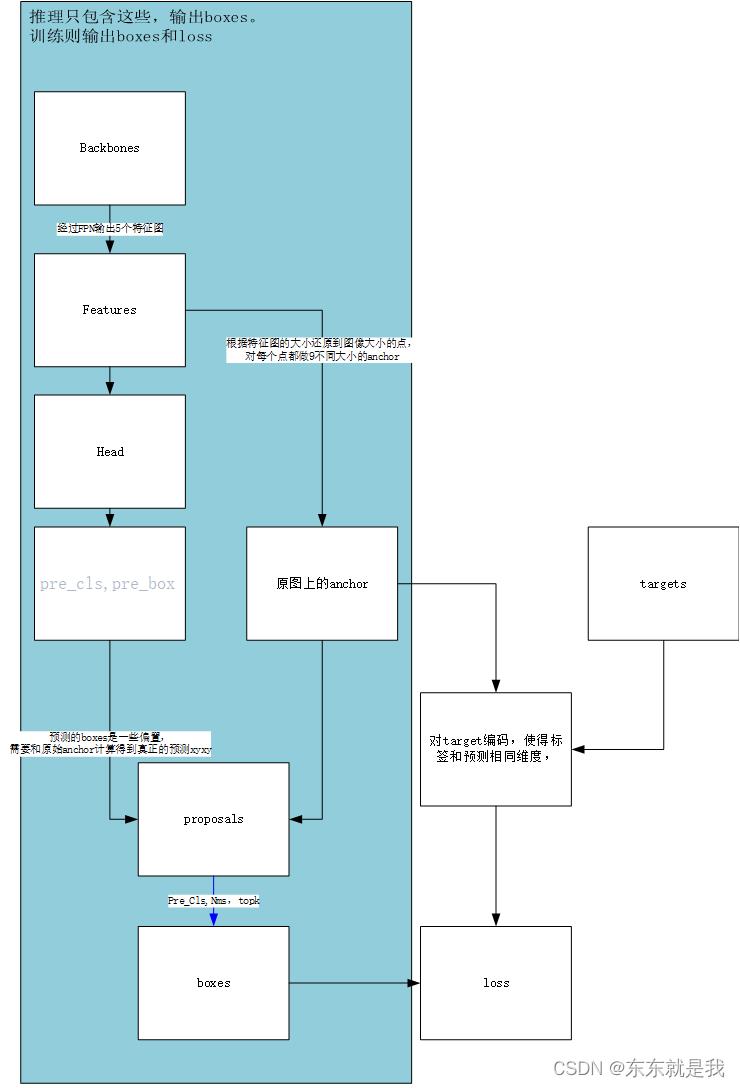目标检测中rpn到底怎么理解
Posted 东东就是我
tags:
篇首语:本文由小常识网(cha138.com)小编为大家整理,主要介绍了目标检测中rpn到底怎么理解相关的知识,希望对你有一定的参考价值。
https://github.com/WZMIAOMIAO/deep-learning-for-image-processing/blob/797f12c91fbb6caaa748c09f16f0cd0fbb9cbd61/pytorch_object_detection/mask_rcnn/network_files/rpn_function.py
import torch.nn as nn
import torch
import torch.nn.functional as F
from typing import List
import utils.det_utils as det_utils
import torchvision
@torch.jit.unused
def _onnx_get_num_anchors_and_pre_nms_top_n(ob, orig_pre_nms_top_n):
# type: (Tensor, int) -> Tuple[int, int]
from torch.onnx import operators
num_anchors = operators.shape_as_tensor(ob)[1].unsqueeze(0)
pre_nms_top_n = torch.min(torch.cat(
(torch.tensor([orig_pre_nms_top_n], dtype=num_anchors.dtype),
num_anchors), 0))
return num_anchors, pre_nms_top_n
class AnchorsGenerator(nn.Module):
def __init__(self,sizes=(128,256,512),aspect_ratios=(0.5,1.0,2.0)):
super(AnchorsGenerator, self).__init__()
self.sizes=sizes
self.aspect_ratios=aspect_ratios
self.cell_anchors=None
self._cache=
def num_anchors_per_location(self):
# 计算每个预测特征层上每个滑动窗口的预测目标数
return [len(s) * len(a) for s, a in zip(self.sizes, self.aspect_ratios)]
# 产生9个不同大小的anchor 中心是(0,0)
def generate_anchors(self,scales,aspect_ratios,dtype=torch.float32,device=torch.device('cpu')):
scales = torch.as_tensor(scales, dtype=dtype, device=device)
aspect_ratios = torch.as_tensor(aspect_ratios, dtype=dtype, device=device)
h_ratios = torch.sqrt(aspect_ratios)
w_ratios = 1.0 / h_ratios
# [r1, r2, r3]' * [s1, s2, s3]
# number of elements is len(ratios)*len(scales)
ws = (w_ratios[:, None] * scales[None, :]).view(-1)
hs = (h_ratios[:, None] * scales[None, :]).view(-1)
# left-top, right-bottom coordinate relative to anchor center(0, 0)
# 生成的anchors模板都是以(0, 0)为中心的, shape [len(ratios)*len(scales), 4]
base_anchors = torch.stack([-ws, -hs, ws, hs], dim=1) / 2
return base_anchors.round() # round 四舍五入
#计算预测特征图还原到原始图像上所有的点的所有anchors的坐标
def grid_anchors(self,gird_sizes,strides):
anchors=[]
cell_anchors=self.cell_anchors
# 遍历每个预测特征层的grid_size,strides和cell_anchors
for size,stride,base_anchors in zip(gird_sizes,strides,cell_anchors):
gird_height,gird_width=size
stride_height,stride_width=stride
device=base_anchors.device
#特征图的坐标还原到原图大小的坐标
shifts_x=torch.arange(0,gird_width,dtype=torch.float32,device=device)*stride_width
shifts_y=torch.arange(0,gird_height,dtype=torch.float32,device=device)*stride_height
#通过坐标还原到原图
shift_y, shift_x = torch.meshgrid(shifts_y, shifts_x)
shift_x = shift_x.reshape(-1)
shift_y = shift_y.reshape(-1)
shifts = torch.stack([shift_x, shift_y, shift_x, shift_y], dim=1)
# 将anchors模板与原图上的坐标偏移量相加得到原图上所有anchors的坐标信息
shifts_anchor = shifts.view(-1, 1, 4) + base_anchors.view(1, -1, 4)
anchors.append(shifts_anchor.reshape(-1,4))
return anchors
# 缓存anchors
def cached_grid_anchors(self,grid_sizes,strides):
key = str(grid_sizes) + str(strides)
if key in self._cache:
return self._cache[key]
anchors=self.grid_anchors(grid_sizes,strides)
self._cache[key]=anchors
return anchors
def set_cell_anchors(self,dtype,device):
if self.cell_anchors is not None:
cell_anchor=self.cell_anchors
if cell_anchor[0].device==device:
return
cell_anchors = [
self.generate_anchors(sizes, aspect_ratios, dtype, device)
for sizes, aspect_ratios in zip(self.sizes, self.aspect_ratios)
]
self.cell_anchors = cell_anchors
def forward(self,image_list,feature_maps):
# 获取每个预测特征层的尺寸(height, width)
grid_sizes = list([feature_map.shape[-2:] for feature_map in feature_maps])
# 获取输入图像的height和width
image_size = image_list.tensors.shape[-2:]
# 获取变量类型和设备类型
dtype, device = feature_maps[0].dtype, feature_maps[0].device
# one step in feature map equate n pixel stride in origin image
# 计算特征层上的一步等于原始图像上的步长
strides = [[torch.tensor(image_size[0] // g[0], dtype=torch.int64, device=device),
torch.tensor(image_size[1] // g[1], dtype=torch.int64, device=device)] for g in grid_sizes]
# 根据提供的sizes和aspect_ratios生成anchors模板 ,以(0,0)为中心的5*3个anchor
self.set_cell_anchors(dtype, device)
# 计算/读取所有anchors的坐标信息(这里的anchors信息是映射到原图上的所有anchors信息,不是anchors模板)
# 得到的是一个list列表,对应每层预测特征图映射回原图的3个anchors坐标信息
anchors_over_all_feature_maps = self.cached_grid_anchors(grid_sizes, strides)
anchors=torch.jit.annotate(List[List[torch.Tensor]],[])
#获取一个bitch下所有图片的所有anchors
for i, (image_height, image_width) in enumerate(image_list.image_sizes):
anchors_in_image = []
# 遍历每层预测特征图映射回原图的anchors坐标信息
for anchors_per_feature_map in anchors_over_all_feature_maps:
anchors_in_image.append(anchors_per_feature_map)
anchors.append(anchors_in_image)
#把每张图片的anchor合在一起
anchors = [torch.cat(anchors_per_image) for anchors_per_image in anchors]
# Clear the cache in case that memory leaks.
self._cache.clear()
return anchors
class RPNHead(nn.Module):
def __init__(self,in_channels,num_anchors):
super(RPNHead, self).__init__()
self.conv=nn.Conv2d(in_channels,in_channels,kernel_size=3,stride=1,padding=1)
self.cls_logits=nn.Conv2d(in_channels,num_anchors,kernel_size=1,stride=1)
self.bbox_pred=nn.Conv2d(in_channels,num_anchors*4,kernel_size=1,stride=1)
for layer in self.children():
if isinstance(layer,nn.Conv2d):
torch.nn.init.normal(layer.weight,std=0.01)
torch.nn.init.constant_(layer.bias,0)
def forward(self,x):
logits=[]
bbox_pre=[]
for i ,feature in enumerate(x):
t=F.relu(self.conv(feature))
logits.append(self.cls_logits(t))
bbox_pre.append(self.bbox_pred(t))
return logits,bbox_pre
def permute_and_flatten(layer,N,A,C,H,W):
layer=layer.view(N,-1,C,H,W)
layer=layer.permute(0,3,4,1,2)
layer=layer.reshape(N,-1,C)
return layer
def concat_box_prediction_layers(box_cls,box_regression):
box_cls_flattened = []
box_regression_flattened = []
for box_cls_per_level,box_regression_per_level in zip(box_cls,box_regression):
N, A, H, W = box_cls_per_level.shape
C=1
# [N, A, H, W]->[N, -1, C]
box_cls_per_level = permute_and_flatten(box_cls_per_level, N, A, C, H, W)
box_cls_flattened.append(box_cls_per_level)
#[N, A*4, H, W] ->[N, -1, C]
box_regression_per_level = permute_and_flatten(box_regression_per_level, N, A, 4, H, W)
box_regression_flattened.append(box_regression_per_level)
box_cls=torch.cat(box_cls_flattened,dim=1).flatten(0,-2)
box_regression=torch.cat(box_regression_flattened,dim=1).reshape(-1,4)
return box_cls,box_regression
class RegionProposalNetwork(torch.nn.Module):
def __init__(self,anchor_generator,head,fg_iou_thresh, bg_iou_thresh,
batch_size_per_image, positive_fraction,
pre_nms_top_n, post_nms_top_n, nms_thresh, score_thresh=0.0):
super(RegionProposalNetwork, self).__init__()
self.anchor_generator=anchor_generator
self.head = head
#todo
self.box_coder=det_utils.BoxCoder(weights=(1.0, 1.0, 1.0, 1.0))
# 计算anchors与真实bbox的iou
#todo
# self.box_similarity = box_ops.box_iou
self.fg_bg_sampler = det_utils.BalancedPositiveNegativeSampler(
batch_size_per_image, positive_fraction # 256, 0.5
)
#根据gt和pre_box的iou对 pre_box分类
self.proposal_matcher = det_utils.Matcher(
fg_iou_thresh, # 当iou大于fg_iou_thresh(0.7)时视为正样本
bg_iou_thresh, # 当iou小于bg_iou_thresh(0.3)时视为负样本
allow_low_quality_matches=True
)
# use during testing
self._pre_nms_top_n = pre_nms_top_n
self._post_nms_top_n = post_nms_top_n
self.nms_thresh = nms_thresh
self.score_thresh = score_thresh
self.min_size = 1.
def pre_nms_top_n(self):
if self.training:
return self._pre_nms_top_n['training']
return self._pre_nms_top_n['testing']
def post_nms_top_n(self):
if self.training:
return self._post_nms_top_n['training']
return self._post_nms_top_n['testing']
# 计算每个anchors最匹配的gt,并划分为正样本,背景以及废弃的样本
def assign_targets_to_anchors(self,anchors,targets):
labels=[]
matched_gt_boxes=[]
# 遍历每张图像的anchors和targets
for anchors_per_image,targets_per_image in zip(anchors,targets):
gt_boxes=targets_per_image["boxes"]
if gt_boxes.numel() == 0:
device = anchors_per_image.device
matched_gt_boxes_per_image = torch.zeros(anchors_per_image.shape, dtype=torch.float32, device=device)
labels_per_image = torch.zeros((anchors_per_image.shape[0],), dtype=torch.float32, device=device)
else:
match_quality_matrix = det_utils.box_iou(gt_boxes, anchors_per_image)
# 计算每个anchors与gt匹配iou最大的索引(如果iou<0.3索引置为-1,0.3<iou<0.7索引为-2)
matched_idxs = self.proposal_matcher(match_quality_matrix)
matched_gt_boxes_per_image = gt_boxes[matched_idxs.clamp(min=0)]
labels_per_image = matched_idxs >= 0
labels_per_image = labels_per_image.to(dtype=torch.float32)
# background (negative examples)
bg_indices = matched_idxs == self.proposal_matcher.BELOW_LOW_THRESHOLD # -1
labels_per_image[bg_indices] = 0.0
# discard indices that are between thresholds
inds_to_discard = matched_idxs == self.proposal_matcher.BETWEEN_THRESHOLDS # -2
labels_per_image[inds_to_discard] = -1.0
labels.append(labels_per_image)
matched_gt_boxes.append(matched_gt_boxes_per_image)
return labels,matched_gt_boxes
#获取每层预测特征图上预测概率排前pre_nms_top_n的anchors索引值
def _get_top_n_idx(self,objectness,num_anchors_per_level):
r=[]
offset=0
for ob in objectness.split(num_anchors_per_level,1):
#采用jit跟踪模型
if torchvision._is_tracing():
num_anchors, pre_nms_top_n = _onnx_get_num_anchors_and_pre_nms_top_n(ob, self.pre_nms_top_n())
else:
num_anchors = ob.shape[1] # 预测特征层上的预测的anchors个数
pre_nms_top_n = min(self.pre_nms_top_n(), num_anchors)
# Returns the k largest elements of the given input tensor along a given dimension
_, top_n_idx = ob.topk(pre_nms_top_n, dim=1)
top_n_idx=top_n_idx.to('cpu')
r.append(top_n_idx+offset)
offset+=num_anchors
return torch.cat(r, dim=1)
# 筛除小boxes框,nms处理,根据预测概率获取前post_nms_top_n个目标
def filter_proposals(self,proposals,objectness,image_shapes,num_anchors_per_level):
num_images = proposals.shape[0]
device = proposals.device
# do not backprop throught objectness
objectness = objectness.detach()
objectness = objectness.reshape(num_images, -1)
# levels负责记录分隔不同预测特征层上的anchors索引信息
levels = [torch.full((n, ), idx, dtype=torch.int64, device=device)
for idx, n in enumerate(num_anchors_per_level)]
levels = torch.cat(levels, 0)
# Expand this tensor to the same size as objectness
levels = levels.reshape(1, -1).expand_as(objectness)
# 获取每张预测特征图上预测概率排前pre_nms_top_n的anchors索引值
top_n_idx = self._get_top_n_idx(objectness, num_anchors_per_level)
image_range = torch.arange(num_images, device=device)
batch_idx = image_range[:, None] # [batch_size, 1]
# 根据每个预测特征层预测概率排前pre_nms_top_n的anchors索引值获取相应概率信息
objectness = objectness[batch_idx, top_n_idx]
levels = levels[batch_idx, top_n_idx]
# 预测概率排前pre_nms_top_n的anchors索引值获取相应bbox坐标信息
proposals = proposals[batch_idx, top_n_idx]
objectness_prob = torch.sigmoid(objectness)
final_boxes = []
final_scores = []
# 遍历每张图像的相关预测信息
for boxes, scores, lvl, img_shape in zip(proposals, objectness_prob, levels, image_shapes):
# 调整预测的boxes信息,将越界的坐标调整到图片边界上
boxes = det_utils.clip_boxes_to_image(boxes, img_shape)
# 返回boxes满足宽,高都大于min_size的索引
keep = det_utils.remove_small_boxes(boxes, self.min_size)
boxes, scores, lvl = boxes[keep], scores[keep], lvl[keep]
# 移除小概率boxes,参考下面这个链接
# https://github.com/pytorch/vision/pull/3205
keep = torch.where(torch.ge(scores, self.score_thresh))[0] # ge: >=
boxes, scores, lvl = boxes[keep], scores[keep], lvl[keep
